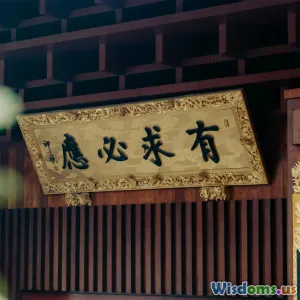
Could Early Dynasties Survive Without Silk Trade
9 min read Exploring the indispensable role of silk trade in the survival and prosperity of early dynasties across ancient civilizations. (0 Reviews)
Could Early Dynasties Survive Without Silk Trade?
The image of silk—shimmering, luxurious, and elusive—often conjures thoughts of wealth, power, and the grandeur of early empires. But was the silk trade merely a luxury industry, or did it constitute a foundational backbone for the survival of early dynastic civilizations? To understand whether early dynasties could have withstood the test of time without the silk trade is to unravel an intricate web of economics, politics, culture, and international relations keyed around this prized commodity.
Introduction: Silk as More Than Just Material Wealth
Silk, first developed in ancient China more than 4,000 years ago, rapidly transcended its status as a mere textile to become a geopolitical tool, an economic catalyst, and a cultural symbol. The Silk Road—the expansive network linking East Asia with the Mediterranean—did not merely trade silk but symbolized a conduit for ideas, technologies, religions, and diplomatic contact.
Archaeological findings, historical records, and economic data illustrate silk's centrality in nourishing empires such as the Han dynasty, the Roman Empire, and later the Byzantine. But what if silk trade had not existed or abruptly ceased—could these dynasties have survived, let alone prospered?
The Economic Backbone: Silk's Role in Early Dynasties
Generating Wealth and Stability
Silk was often considered the currency of ancient economies. The Han dynasty used silk to pay for horses from the nomadic tribes of Central Asia, critical for the empire’s military resilience. Records suggest these exchanges helped stabilize frontier relations and secure trade routes that safeguarded dynastic borders.
Moreover, silk production and trade created vast employment across different layers of society—from sericulture and weaving to merchant caravans. According to historian Valerie Hansen, the average sericulture workforce in ancient China was embedded deep into the rural fabric, contributing to socio-economic stability.
Financing Governance and Military Expansion
Without silk revenues, dynastic treasuries would face significant deficits. For example, Taoism and Confucian ideals revered frugality, and the state’s revenue from silk exports often funded infrastructure projects such as the Great Wall and regional fortifications. Similarly, the Han dynasty’s naval advancements were partially subsidized through silk trade profits.
Silk Against Economic Alternatives
While the Silk Road offered other commodities such as spices, jade, and ceramics, silk uniquely combined durability, portability, and demand across cultures. Thought experiments grounded in economic history argue that absent the silk trade, reliance on less valuable or perishable goods would have curtailed diplomatic engagement and economic growth.
Political and Diplomatic Implications
Silk as a Diplomatic Leverage
Silk was a diplomatic currency. Chinese emperors gifted silk robes to foreign emissaries, symbolizing trust and hierarchical order. The absence of silk diminished such soft power. For instance, embassies from Central Asia and South Asia often operated within the silk trade framework to legitimize their sovereignty and relations with China.
Maintaining Frontier Peace and Strategic Alliances
By trading silk for horses and alliances with nomadic tribes, early Chinese dynasties secured their volatile northern frontiers. This exchange network was more than commerce—it was a subtle form of diplomacy that deterred invasions and ensured mutual interests. The loss of silk trade would have exposed dynasties to the risk of hostile incursions from less pacified tribes.
Impact on Rival Empires
Rome’s fascination with silk famously underlined delicate economic dependencies. Roman emperors imported large volumes of silk, often leading to bullion drain that worried economic commentators. Yet, the allure of silk helped sustain diplomatic dialogues between East and West.
Had silk trade been absent, early dynasties might have sought alternative alliances or conflagrated conflicts to secure resources that silk once replaced.
Cultural and Societal Resonance
Silk in Social Structure and Identity
Silk was more than fabric; it was an identity marker. In China, Confucius himself referenced silk in his works, highlighting its role in rituals and court presentations. Dynastic regulations often controlled silk clothing, restricting it to nobility and clergy—a policy that shaped social hierarchies.
Technological Innovation and Knowledge Exchange
Silk trade routes were conduits for exchanging astronomical knowledge, medical practices, and religious ideas (e.g., Buddhism). Without the silk network, such cross-cultural fertilization would have been impaired, leading to slower intellectual and technological development.
Art and Literature Inspired by Silk
From Chinese poetry praising the elegance of silk garments to Byzantine mosaics depicting silk drapery, silk inspired numerous art forms. Its disappearance might have diminished cultural richness and diversity in these early dynasties.
Case Study: Han Dynasty and the Silk Road
The Han dynasty represents a quintessential example illustrating why silk was indispensable to early dynasties.
- Economic Dimensions: Silk exports provided the Han treasury hundreds of thousands of ounces of silver worth annually.
- Military Strategy: Horses exchanged for silk allowed Han military dominance on horseback—a decisive advantage.
- Diplomatic Outreach: The opening of the Silk Road promoted tributary states and secured allies deep into Central Asia.
Without silk, the Han dynasty could arguably have collapsed into fragmentation or been overwhelmed by nomadic confederations. Their ability to project and maintain power would have diminished drastically.
Counterfactuals: Possible Surviving Strategies Without Silk Trade
Diversifying Trade Commodities
Could early dynasties have survived by focusing solely on other commodities? Spices, ceramics, jade, and metals played roles, but none matched silk in combined value and diplomatic utility.
Strengthening Internal Economies
Self-sufficiency might have promoted agricultural or metallurgical expansions; however, historical evidence shows such inward focus frequently resulted in stagnation without vibrant external trade.
Alternative Diplomatic Tools
Without silk gifts, dynasties might have adopted gold, horses, or technologies as diplomatic currencies. Nevertheless, these alternatives lacked the symbolic weight and fluid trade value that silk held.
Military Realignment
Without silk, dynasties would have faced increased military pressure due to diminished horse supplies, leading to possible territorial losses.
In sum, while survival could be imagined, all evidence suggests prosperity and influence would have been greatly curtailed.
Conclusion: Silk as the Lifeblood of Early Dynasties
Examining economic policies, diplomatic maneuvers, cultural dynamics, and military logistics, the evidence converges on the indispensability of the silk trade to early dynasties. Silk was neither an ornamental luxury nor trivial commodity—it was a strategic linchpin.
Early dynasties like the Han could not only survive but flourish due to the multifaceted benefits silk trade rendered—from wealth generation and military equipping to diplomatic recognition and cultural vitality. Its removal or absence would have delivered a considerable blow, limiting territorial expansion, economic development, and intercultural exchange.
Today, as global supply chains and cultural integrations continue evolving, the lessons from the silk trade remind us of how critical trade and soft power are to political resilience and societal enrichment. Indeed, early dynasties not only survived because of silk—they thrived, shaping the foundations of civilizations that continue to influence the modern world.
Rate the Post
User Reviews
Popular Posts



















